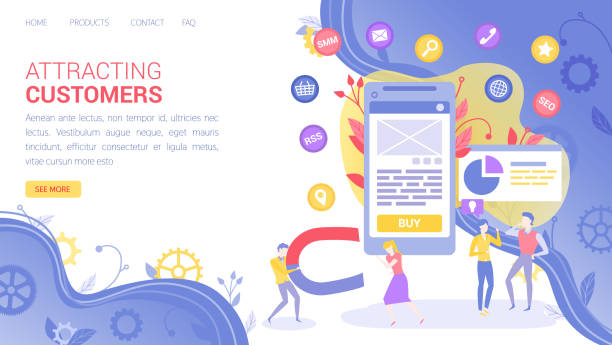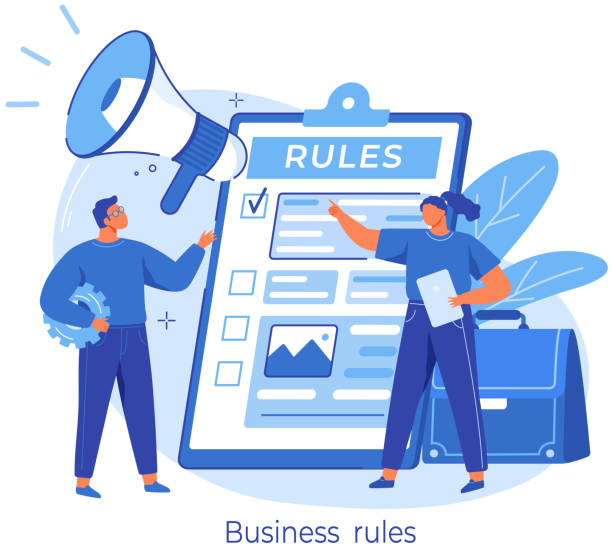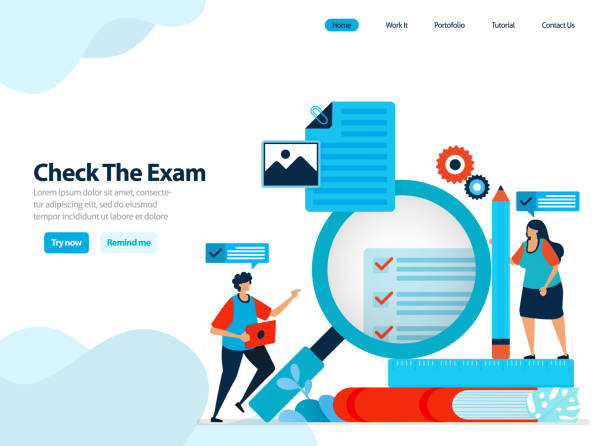The Importance of Fast Website Design for Modern Businesses

In today’s digital world, website speed is no longer a competitive advantage, but a vital necessity.
Internet users have high expectations for page loading speed, and if there’s a delay, they quickly leave the site.
#Website_Speed and #User_Experience are two inseparable factors that directly impact your business’s online success.
A slow website not only drives away visitors but also lowers its ranking in Google search results, which means losing traffic and potential customers.
The importance of fast website design in the current era is so high that tech giants like Google have incorporated speed metrics as primary ranking factors in their algorithms.
This is crucial educational and explanatory content for any business looking to succeed in the online space.
Users expect websites to load in less than a few seconds, and every millisecond of delay can mean a decrease in conversion rates and an increase in bounce rates.
Therefore, investing in website speed optimization and fast website design is considered a smart and strategic move for the sustainability and growth of any online business.
In this article, we will professionally delve into various aspects of this topic and provide practical guidance for achieving a high-speed website.
Is your e-commerce site ready to attract maximum customers and increase sales? Rasaweb transforms your online business with modern and efficient e-commerce website designs.
✅ Increased speed and SEO improvement
✅ Excellent user experience on mobile and desktop⚡ Get free e-commerce website design consultation from Rasaweb!
Key Factors Affecting Website Speed

The loading speed of a website is influenced by several factors, and understanding them is essential for achieving fast website design.
The first and perhaps most important factor is the quality of your hosting or web host.
Inexpensive shared hosting often has limited resources, which can lead to a slow website.
Choosing a Virtual Private Server (VPS) or a dedicated server with sufficient resources is a big step towards increasing speed.
The second factor is the quality and optimization of website coding.
Bulky and unoptimized JavaScript and CSS codes can significantly increase loading time.
Using lightweight frameworks and clean, minified coding has a significant impact.
The third factor is optimizing images and multimedia content.
High-volume images are the biggest cause of slowness for many websites.
Compressing images without significant quality loss, using modern formats like WebP, and implementing Lazy Loading (بارگذاری تنبل) for off-screen images are essential.
The fourth factor is the number and size of HTTP requests.
Every file (image, CSS, JS) that the website needs to load creates an HTTP request.
Reducing the number of these requests by combining files or using a Content Delivery Network (CDN) significantly helps improve speed.
These are specialized factors and essential guidelines for anyone seeking a high-speed website.
Speed Optimization Techniques and Tools

To achieve a fast website design, a set of specialized techniques and tools work systematically.
One of the most important is Caching.
Caching allows browsers to store your website’s static files (such as images, CSS, and JavaScript) for subsequent visits, which significantly reduces loading time for returning visitors.
The second vital technique is Minification of codes.
This process involves removing unnecessary characters like white spaces, new lines, and comments from HTML, CSS, and JavaScript files, which reduces file size and increases loading speed.
Content Delivery Network (CDN) is also a powerful tool that stores your website’s content on various servers worldwide, and the server closest to the user delivers the content, which significantly helps reduce network latency.
Another technique is enabling GZIP compression on the server, which drastically reduces the size of text files before sending them to the browser.
Using the Lazy Loading technique for images and videos, especially on long pages, ensures that these elements are only loaded when the user scrolls to the relevant section, which in itself reduces the initial page load.
These techniques are part of the specialized guidelines for fast website design that enable analytical website optimization.
Speed analysis tools like Google PageSpeed Insights and GTmetrix also provide valuable information about your website’s strengths and weaknesses in terms of speed, which are essential for troubleshooting and continuous improvement.
| Technique/Tool | Description | Impact on Speed |
|---|---|---|
| Caching | Temporary storage of data in the user’s browser or on the server | Reduces repeated loading time for returning visitors |
| Minification | Removing white spaces and extra characters from code (HTML, CSS, JS) | Reduces file size and speeds up their download |
| Content Delivery Network (CDN) | Distributes content from the server closest to the user | Reduces network latency and increases global loading speed |
| Lazy Loading | Loading images and videos only when needed (when the user scrolls to them) | Reduces initial page load and improves initial performance |
| Image Compression | Reduces image size without significant quality loss | Faster loading of visual elements and reduction of overall page size |
The Impact of Mobile Responsiveness on Speed and User Experience

In an age where most users access the internet via mobile devices, Responsive Design is not just an attractive feature, but a vital requirement for fast website design.
A responsive website automatically adjusts itself to the user’s device screen size, providing a seamless and optimized experience.
But why is this so related to speed? Non-responsive websites on mobile devices require zooming and horizontal scrolling, which itself increases rendering time and consequently reduces speed.
Furthermore, content may not display correctly, forcing users to load desktop versions of the site that are not optimized and consume more bandwidth.
Google is also increasingly emphasizing the importance of Mobile-First Indexing, meaning that your website’s mobile version is the primary criterion for ranking in search results.
A high-speed and responsive website on mobile directly impacts your SEO and ranking in search engines.
A slow mobile website not only disrupts the user experience but also leads to an increase in bounce rate and a decrease in conversion rate.
This is explanatory and analytical content that shows how website speed on different devices affects the overall success of your business.
Optimizing for mobile means designing the website with a “mobile-first” approach, ensuring that all elements load quickly and correctly even on the smallest screens.
Are you worried that your company’s old website is driving away new customers? Don’t worry anymore! With Rasaweb’s corporate website design services:
✅ Your brand credibility increases.
✅ It helps attract targeted customers.
⚡ Contact Rasaweb for a free consultation!
User Experience and Its Connection to Website Speed

User Experience (UX) and website speed are two sides of the same coin that heavily influence each other.
In fact, speed is one of the fundamental pillars of a positive user experience.
Imagine you’re searching for information online and click on a link; if the page takes more than a few seconds to load, how would you feel? You’d probably get frustrated and quickly move to another site.
This scenario occurs frequently and highlights the importance of fast website design more than ever.
A slow website not only frustrates users but also harms your brand.
Users associate speed with the efficiency and professionalism of a business.
If your website is slow, you unconsciously convey the feeling to the user that your business is also slow and inefficient.
This can lead to a loss of trust and ultimately customers.
Furthermore, speed directly impacts the Bounce Rate and Conversion Rate.
Slow websites have higher bounce rates, meaning users quickly leave the site without taking any specific action.
In contrast, high-speed websites keep users more engaged and increase the likelihood of them making a purchase or performing your desired action.
This is entertaining yet explanatory content that highlights the importance of speed from the end-user’s perspective and demonstrates how website speed improvement can directly affect your business results.
Website speed is not just a technical factor but a vital element in user psychology and their decision to stay on or leave a page.
Measuring Website Speed and Performance Metrics

To achieve and improve fast website design, we must first correctly measure its speed.
Various tools exist for evaluating website performance, each offering its specific metrics.
Among the most prominent are Google PageSpeed Insights, GTmetrix, and Lighthouse.
These tools provide scores and recommendations for optimization, which can serve as precise guidance for developers and website administrators.
Among performance metrics, Google’s Core Web Vitals are of particular importance.
These three metrics include Largest Contentful Paint (LCP), First Input Delay (FID), and Cumulative Layout Shift (CLS).
LCP indicates the time required for the largest visual element on the page to load.
FID measures the delay between the user’s first interaction with the page (e.g., clicking a button) and the browser’s response.
CLS evaluates the visual stability of the page, meaning the amount of unexpected layout shifts during loading.
In addition to Core Web Vitals, other metrics such as First Contentful Paint (FCP) (time to load the first content) and Time to Interactive (TTI) (time required for the page to become fully interactive) are also important.
Regularly reviewing these metrics and striving to improve them is an integral part of website maintenance and optimization.
This analytical information and precise guidance will help you gain a deep understanding of your website’s performance and take effective steps to increase its speed.
Common Mistakes in Website Design and Ways to Avoid Them

On the path to achieving fast website design, there are some common mistakes that can negate your efforts.
Understanding these mistakes and how to avoid them is a thought-provoking but highly specialized topic.
The first mistake is using unoptimized images.
Many websites load images without compression or in inappropriate formats, which severely reduces speed.
The solution is to always compress images before uploading and use modern formats like WebP.
The second mistake is heavy and unoptimized coding.
Using excessive and uncompressed HTML, CSS, and JavaScript codes can increase page size.
It’s best to minify codes and avoid unnecessary ones.
The third error is choosing inappropriate hosting.
Inexpensive and low-quality hosting often causes website slowness due to limited server resources.
Investing in reliable and high-quality hosting is an essential step for speed.
The fourth mistake is a large number of HTTP requests.
Every file (image, font, script) that the website needs to load creates an HTTP request.
By combining CSS and JavaScript files and using image sprites, the number of these requests can be reduced.
Finally, excessive use of plugins or add-ons in Content Management Systems like WordPress can severely reduce speed due to increased server load and conflicts.
Always choose essential and high-quality plugins and get rid of inactive or rarely used ones.
Adhering to these points provides essential guidance for maintaining website loading speed.
| Common Problem | Description | Solution |
|---|---|---|
| Unoptimized Images | High volume of images without proper compression or in old formats | Compress images, use WebP formats, Lazy Loading |
| Heavy and Unoptimized Coding | Bulky, repetitive, or space-containing HTML, CSS, JS files | Minify codes, remove unnecessary codes, optimize code structure |
| Weak and Inappropriate Hosting | Insufficient server resources, overcrowded shared servers | Choose reliable hosting suitable for site traffic (VPS, Dedicated) |
| Too Many HTTP Requests | Loading too many separate files for each page | Combine CSS and JS files, use image sprites, reduce external scripts |
| Excessive Use of Plugins/Add-ons | Too many or low-quality plugins consuming system resources | Choose essential and optimized plugins, remove inactive plugins |
The Role of Platform and CMS Selection in Speed

Choosing the right platform and Content Management System (CMS) is one of the critical decisions in the process of fast website design.
Every CMS, like WordPress, Joomla, or Drupal, has its own structure and architecture that can affect website speed.
WordPress, as the most popular CMS in the world, offers high flexibility, but if not optimized correctly, it can lead to a slow website.
This slowness often results from the overuse of heavy and unoptimized themes and plugins.
In contrast, simpler Content Management Systems or custom-coded websites can have higher speeds because they only contain essential codes and are free from the extra burden of extensive plugins or frameworks.
However, their development and maintenance require more technical expertise.
For a high-speed website based on a CMS, choosing lightweight and speed-optimized themes, using the minimum number of essential and high-quality plugins, and correctly configuring caching and database optimization settings are of high importance.
This section contains specialized information and practical guidance for website administrators.
Furthermore, regular updates of the CMS and plugins are crucial not only for security but also for performance, as new versions often include performance improvements and bug fixes.
A good Content Management System, with support for server-side and client-side caching, can significantly impact website loading speed.
Therefore, before starting the design, you should evaluate your needs and choose a platform that both meets your requirements and fully supports speed optimization capabilities.
Tired of losing business opportunities due to not having a professional corporate website? Worry no more! With Rasaweb’s corporate website design services:
✅ Your brand’s credibility and professionalism will increase.
✅ You will attract more customers and sales leads.
⚡ Get a free consultation now to get started!
Future Trends in Web Speed Optimization

The web world is constantly evolving, and web speed optimization is no exception.
Future trends in fast website design are moving towards the use of more advanced technologies and innovative approaches.
One such trend is Progressive Web Apps (PWAs), which provide a native-app-like user experience through the browser.
PWAs, with powerful caching capabilities and offline functionality, can significantly increase website speed and accessibility.
Another trend is the widespread use of Serverless Architecture.
In this model, developers do not need to manage servers, and cloud services automatically allocate resources based on demand.
This approach can help reduce latency and improve scalability.
Also, with advancements in Artificial Intelligence (AI) and Machine Learning (ML), we are seeing the emergence of tools that automatically optimize website codes, compress images, and even suggest the best caching strategies.
This is news and analytical content that illustrates new horizons in speed optimization.
New technologies like HTTP/3 and QUIC are also expanding, offering more efficient communication protocols for the web and inherently increasing data transfer speeds.
Furthermore, there’s a growing emphasis on Visual UX and metrics related to fast rendering such as Speed Index and Time to First Byte (TTFB) in on the rise.
Keeping pace with these trends is essential for maintaining a high-speed website and staying competitive in the future.
These developments indicate that speed optimization is not a static process but requires continuous updating and adaptation to emerging technologies.
Final Steps to Achieve Optimal Website Speed

At the end of this comprehensive guide on fast website design, we can summarize the final and essential steps to achieve and maintain optimal website speed.
The first step is continuous monitoring and measurement.
Website speed is not a static state and can change over time with the addition of content, new plugins, or increased traffic.
Regularly using tools like Google PageSpeed Insights and GTmetrix helps you quickly identify and resolve any speed drops.
The second step is regular updates and maintenance.
Ensure that your Content Management System (CMS), theme, and plugins are always updated to the latest version.
These updates often include security and performance improvements that contribute to the overall site speed.
The third point is optimal server configuration and the use of quality hosting.
Ensure that your server supports new technologies like HTTP/2 (and in the future HTTP/3) and that server-side caching settings are correctly implemented.
Finally, it should be remembered that website speed is a critical factor for SEO, user experience, and conversion rates.
By adhering to the principles of fast website design and implementing optimization techniques, you can have a powerful and competitive website that not only satisfies users but also helps your business grow.
These are the final guidelines for a high-speed website and long-term success.
Frequently Asked Questions
| Question | Answer |
|---|---|
| What does fast website design mean? | Optimizing a website for quick page loading in users’ browsers, which leads to a better user experience and higher search engine rankings. |
| Why is website loading speed important? | It increases user satisfaction, reduces bounce rate, improves SEO, and increases conversion rates, as users expect sites to open quickly. |
| What factors affect website speed? | Image size, unoptimized coding (CSS, JS, HTML), inappropriate hosting choice, lack of caching, high number of HTTP requests, and not using a CDN. |
| How can website loading speed be improved? | Compressing images, optimizing and minifying codes, using caching, enabling Gzip compression, using a CDN, and choosing powerful hosting. |
| What is a CDN and how does it help website speed? | A CDN (Content Delivery Network) stores website content on various geographical servers, and the server closest to the user delivers the content, which reduces loading time. |
| How significant is hosting’s role in website speed? | Very significant. Powerful and suitable hosting with sufficient resources, high bandwidth, and optimized servers forms the foundation of a website’s speed. |
| How does image optimization affect website speed? | Images are usually the heaviest part of a web page. Compressing and optimizing them without significant quality loss drastically reduces page size and increases loading speed. |
| Does website speed affect SEO? | Yes, Google and other search engines consider website speed as a ranking factor. Faster websites have a greater chance of ranking higher. |
| What tools are available for measuring website speed? | Google PageSpeed Insights, GTmetrix, Pingdom Tools, and Lighthouse, each providing reports and suggestions for speed improvement. |
| How does Caching help website speed? | Caching causes static site content to be stored for users’ subsequent visits. As a result, the browser does not need to re-download all content, and pages load much faster. |
And other advertising services from Rasaweb Advertising Agency:
Smart Advertorial: An effective tool for increasing sales with intelligent data analysis.
Smart UI/UX: Designed for businesses looking to increase click-through rates through user experience customization.
Smart Data Analysis: An innovative platform for improving SEO ranking by managing Google Ads.
Smart Marketing Automation: A dedicated service for increasing website traffic growth based on Google Ads management.
Smart UI/UX: A combination of creativity and technology to increase click-through rates by precise audience targeting.
And over hundreds of other services in the field of internet advertising, advertising consulting, and organizational solutions.
Internet Advertising | Advertising Strategy | Advertorial
Sources
Fast Website DesignBusiness TransformationWebsite Speed OptimizationImpact of Website Speed on SEO
? To shine in the digital world and reach the pinnacle of success, Rasaweb Afarin Digital Marketing Agency is with you, offering comprehensive services including professional website design and SEO, to elevate your business to the position it deserves.
📍 Tehran, Mirdamad Street, next to Bank Markazi, Southern Kazeroon Alley, Ramin Alley, No. 6



